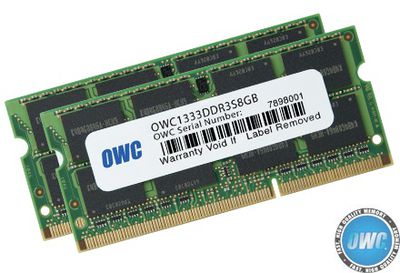
Other World Computing today announced the debut of new aftermarket RAM upgrades for the new MacBook Pro models released late last month. Options ranging up to 16 GB are available, well beyond Apple's maximum build-to-order offering of 8 GB. OWC offers the following options and prices:
- 4 GB (Replace one existing 2 GB module with a 4 GB module for a total of 6 GB): $59.99
- 8 GB (Replace existing 2 GB modules with 4 GB modules): $112.99
- 12 GB (Replace existing 2 GB modules with one 8 GB module and one 4 GB module): $879.99
- 16 GB (Replace existing 2 GB modules with 8 GB modules): $1599.99
Trade-in rebates of $13 per 2 GB module from Apple can also be applied.
OWC maintains a "MaxRAM" testing lab of Apple machines and has verified that the new MacBook Pros can accept up to 16 GB of RAM.
























Top Rated Comments
Not everybody does as little with their machine as you do.
I need 16GB. I support Windows and Macs in a domain environment. I can't very well be asking people 'please hang on while I reboot into Windows' or vise-versa, so I run them side-by-side with VMWare Fusion. With stock 8GB I was able to give 4GB to each OS but that's a pretty small amount by today's standards (and considering I'm currently running 13 management-type programs just in Windows), so I upgraded to 16GB total and gave 8GB to each. The difference was night and day.
After that I put in a 7200RPM hybrid drive and it got even better...
When I first saw those prices on the front page I was sure it was a typo until I read the date...
2. Alternatively, simulating trust relationships between AD domains, development lab for Exchange upgrades, etc.
There are plenty of uses for 16gb of RAM or more, if i had 32GB in my laptop i could certainly make use of it. I'm constantly hitting the limitations of 8GB at the moment at work and am likely to pop 16GB in my home machine (the MBP below) shortly so I can get things done at home instead.
Having a heap of RAM in my personal laptop means I can simulate a hell of a lot of stuff without needing to build a test lab.
although it is amazing how much the pricing has dropped..
What 95% of people do 99% of the time on their computers could be done with an iPad. It's what 95% of people do 1% of the time, or the other 5% do a little bit more often, that demands a desktop class computer (including laptops these days), faster CPU's, more RAM, etc.) Even some who push technology to the limits STILL check their email, browse facebook, check internet forums, shop online, etc. All things any cellphone from the last 5 years (or more) can do. It's the once in a while, niche, odd, intense situation you need it for.
Or, in the case of RAM, simply because the cost (when you do it yourself) is so much minimally more than an 8 gig upgrade.
In my own personal use though, it's being able to run applications like photoshop, while simultaneously running Linux and Windows 7 in two separate VM's on separate desktops (swiping between them like desktops, such a great way to use the 'full screen' apps feature!)
I could squeeze that into 8 gigs depending on what apps I'm running, or spill over into Virtual memory, but, when it's $20 more to go to 16 gigs over 8 gigs, why the heck not? It allows me to do those rare, once in a while tasks like that. Or, heck, just be lazy and leave the VM's running even when I'm not using them. It's easily worth $20.
Plus, I've got a 500 gig SSD (well, two 256 gigs in RAID 0), and I use about 120 gigs right now. How silly would it be to have a 128GB SSD, then swap it to a 256GB SSD when that gets full, etc. etc., Why not just get setup with 500 gigs of storage knowing that, down the road, I might use it? Again, the costs of buying it all at once is cheaper than incremental upgrades.